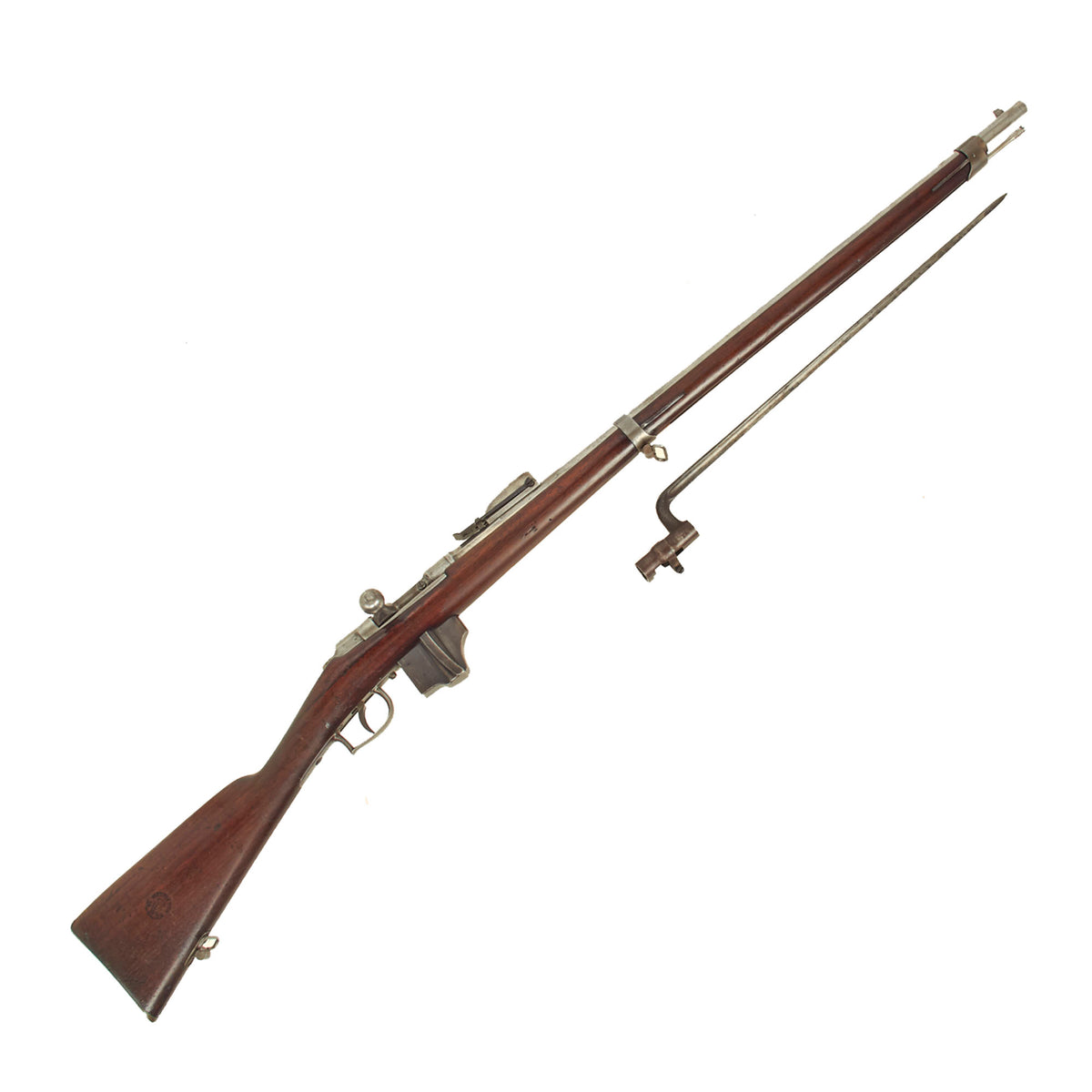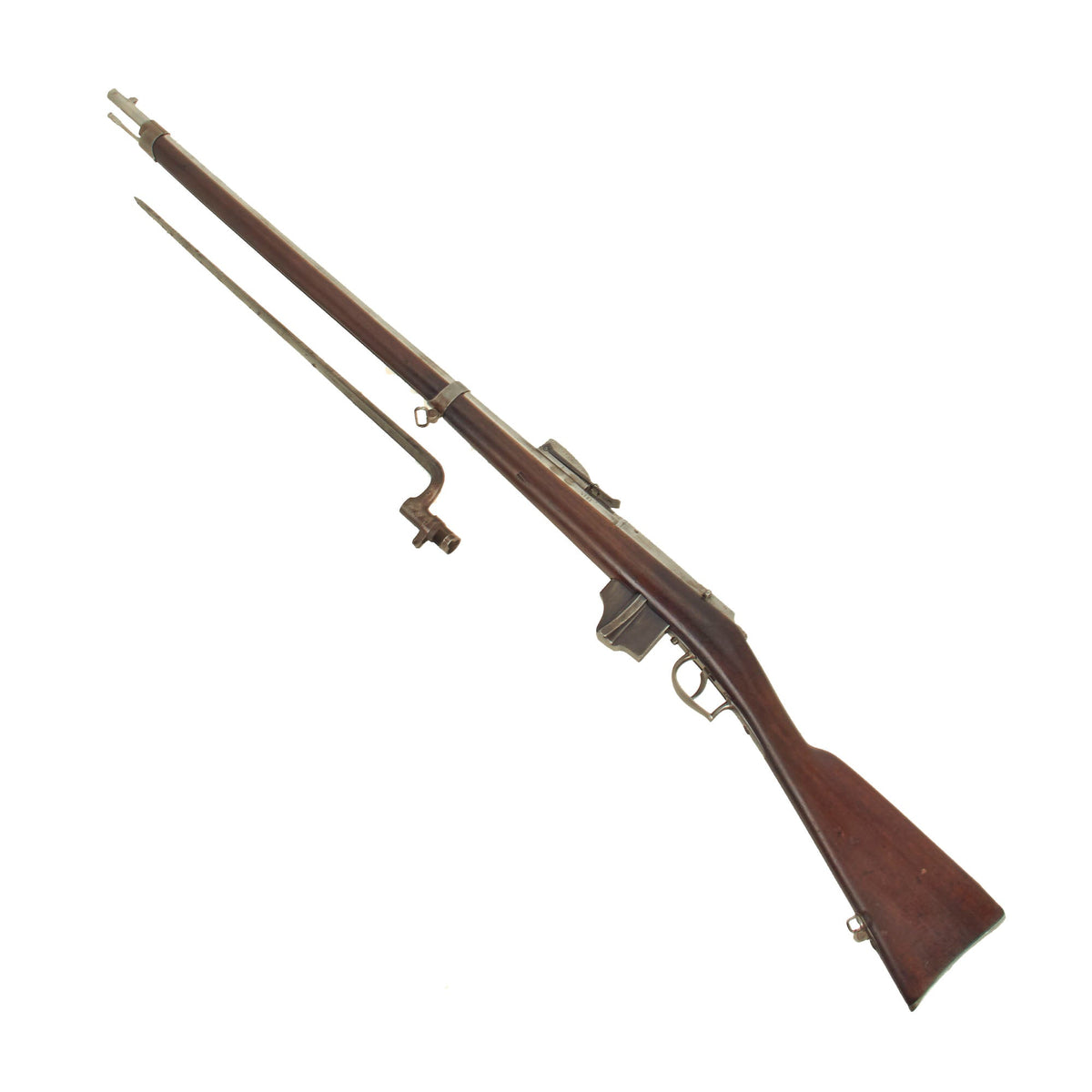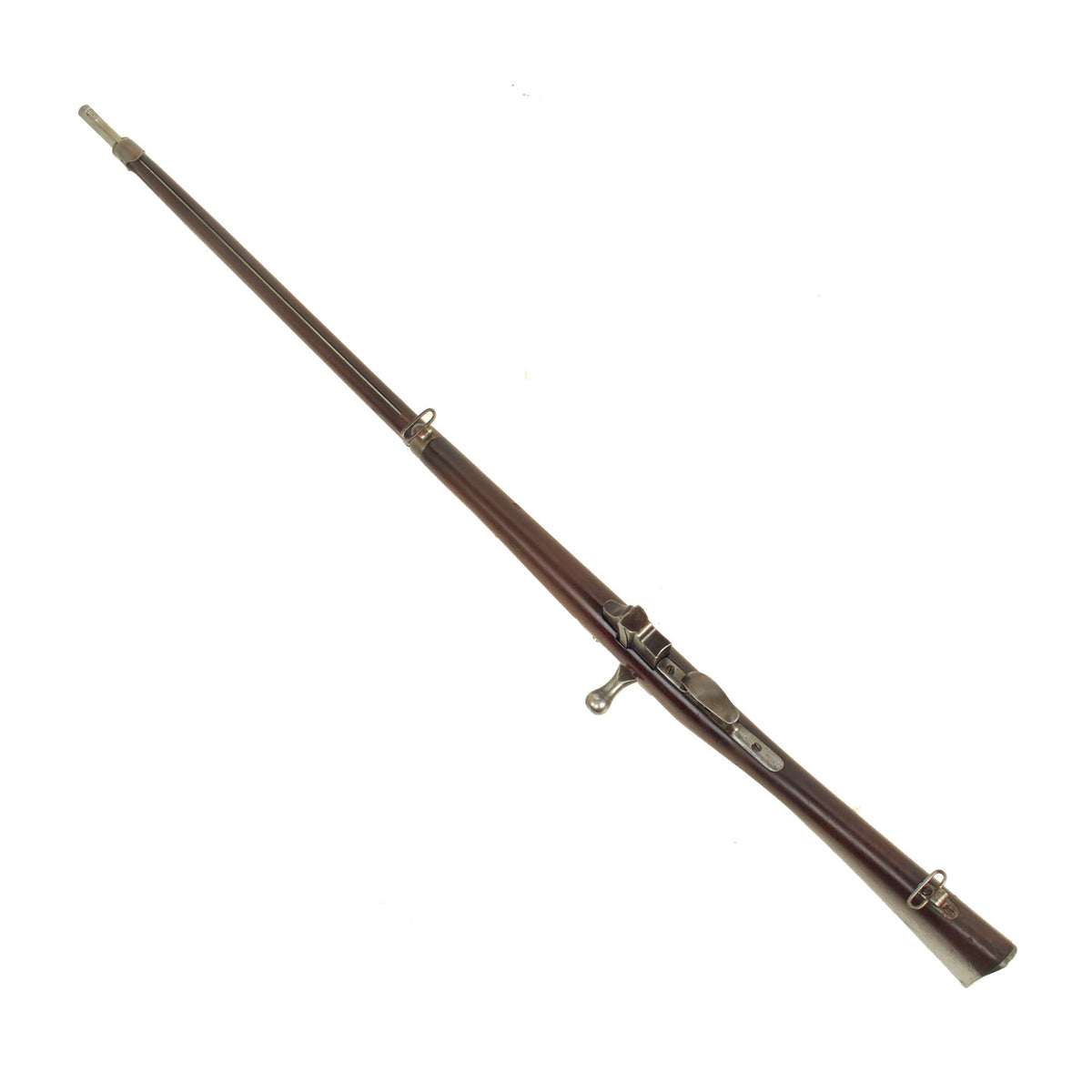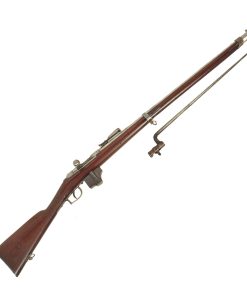Original Dutch Beaumont-Vitali M1871/88 Bolt Action Magazine Conversion Rifle Serial 4383 with Bayonet – Dated 1873 Original Items
$ 795,00 $ 238,50
Original Item: Only One Available. This Dutch Infantry Rifle was made by Stevens in Maastricht in the Netherlands, and is actually dated 1873. The model M-71 was a single shot 11mm rifle that was converted to a bolt-action magazine rifle with a capacity of four rounds in 1891. This magazine system was introduced in 1888, derived from Vitali’s improvements to the Italian Vetterli rifle, and led to the designation Beaumont-Vitali M1871/88. Our example also comes with an original bayonet, which are seldom encountered.
This example has serial number 4383 on the barrel and butt plate, and numbers V 553 on the bolt components, above the chamber on the receiver, as well as on the magazine floor plate. This is normal for the converted rifles, as the action had to be rebuilt. The barrel is dated 1873, and the receiver is clearly marked with maker P. STEVENS / MAASTRICHT. It is in nice condition overall with a nice refinished stock, still bearing a relatively clear MAASTRICHT / 1874 cartouche with CROWN / W in the middle. Additionally, the butt plate is marked 1891, indicating the year it was converted to the bolt-action magazine system.
The rifle is in very good overall condition, complete with the original cleaning rod, often missing. The metalwork has a polished bright steel patina overall, showing careful cleaning over the years, giving it a lovely matte finish. There is some minor staining and past pitting, but nothing out of the ordinary. All components are solid and the bolt moves crisply, though there is a bit of slop due to wear. The magazine cutoff is present and functional. The bore is in very good near excellent condition, with crisp lands and grooves and a bright finish. There are just a few areas of oxidation, and it looks to have seen very little firing during its service life.
The wood stock is quite nice, with a very nice dark red brown color and finish. It has the usual dents and dings expected on a rifle used in service, but no major structural damage we can see. Both sling swivels are present and move, but they are a bit stiff.
The included cruciform-blade socket bayonet is something we rarely see, as they were usually discarded. It is in very good condition, showing an aged bright patina, with some areas of peppering and light pitting. The bayonet fits great, with no issues removing it or locking on.
Still in use by the time WW1 came in 1914 but was much outclassed by the Mauser and Enfield rifle systems introduced in the late 1890s. An unusual system, the bolts spring is in fact housed inside the bolt handle, from an era of great firearms development worldwide, the dawn of the breech-loading period this is unusual and not easy to find. Ready to display!
Specifications (Rifle):-
Year of Manufacture: 1873 – converted 1891
Caliber: 11.3mm x 51R Dutch Beaumont
Cartridge Type: Centerfire Cartridge
Barrel Length: 32 Inches
Overall Length: 52 Inches
Action type: Bolt-Action
Feed System: 4 Round Magazine
Specifications (Bayonet):-
Blade Length: 20 1/2″
Blade Style: Cruciform Socket
Overall length: 23“
History of the Beaumont:
Created in 1871 by a Dutch engineer named Messerecht, the Dutch Beaumont rifle was one of the first metallic cartridge bolt-action rifle to be adopted by any military. Firing an 11.3x50mm cartridge it was single shot only, meaning the user had to insert a new cartridge after every shot. Unlike other rifles, the mainspring of the Beaumont was located within the bolt handle, an exact copy of the Mauser Norris rifle, which would also be copied by the Japanese with the Murata rifle. This same feature, however, made it impossible to turn down the bolt on cavalry and carbine models.
While the Beaumont was state of the art for its day, by the late 1880’s it was obsolete as repeating rifles became all the rage in Europe. To make up for the Beaumont’s deficiency, the Dutch added a magazine to the rifle, the same type of magazine used by the Italians when they converted their single shot Vetterli rifles into repeaters. Since the Beaumont was outfitted with the Italian Vitali magazine in 1888, it was redubbed the Beaumont-Vitali Model 1871/88. The Vitali magazine held four rounds and was reloaded with an en bloc clip made of cardboard. When the clip was empty, an attached string was pulled to remove it from the magazine, no kidding.
Despite the upgrade the Beaumont-Vitali, much like the Italian Vetterli Vitali, was obsolete by the time it was introduced. By 1890 nations began to adopt smokeless powder designs which used smaller caliber high velocity cartridges firing conical shaped spitzer bullets. Eventually the Dutch phased out the Beaumont-Vitali and replaced it with the M95 Steyr-Hembrug.
NOTE: International orders of antique firearms MUST be shipped using UPS WW Services (courier). USPS Priority Mail international will not accept these. International customers should always consult their country’s antique gun laws prior to ordering.
Fast Shipping with Professional Packaging
Thanks to our longstanding association with UPS FedEx DHL, and other major international carriers, we are able to provide a range of shipping options. Our warehouse staff is expertly trained and will wrap your products according to our exact and precise specifications. Prior to shipping, your goods will be thoroughly examined and securely secured. We ship to thousands clients each day across multiple countries. This shows how we're dedicated to be the largest retailer on the internet. Warehouses and distribution centres can be located throughout Europe as well as the USA.
Note: Orders with more than one item will be assigned a processing date depending on the item.
Before shipping before shipping, we'll conduct a thorough inspection of the items you have ordered. Today, the majority of orders will be delivered within 48 hours. The delivery time will be between 3-7 days.
Returns
The stock is dynamic and we cannot completely manage it because multiple stakeholders are involved, including our factory and warehouse. So the actual stock may alter at any time. It's possible that you may not receive your order once the order has been made.
Our policy is valid for a period of 30 days. If you don't receive the product within 30 days, we are not able to issue a refund or an exchange.
You can only return an item if it is unused and in the same state as the day you received it. You must have the item in its original packaging.
Related products
Uncategorized
Uncategorized
Australian WWII Owen MK1 Machine Carbine SMG Custom Fabricated Replica with Sling Original Items
Uncategorized
Armoured Fighting Vehicles of the World: AFVs of World War One (Hardcover Book) New Made Items
Uncategorized
Uncategorized
Uncategorized
Uncategorized
Uncategorized
Uncategorized
Uncategorized
Uncategorized
Uncategorized
Uncategorized
Uncategorized
Angolan Rebel 1970s era 60mm Inert Display Mortar from Angolan Civil War Original Items
Uncategorized
Uncategorized
Uncategorized












































































